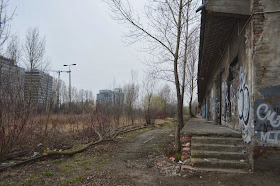For those who've never been - Edinburgh's historic centre is divided into a mediaeval old town (Auld Toun) and a Regency new town. The main thoroughfare of the former is the Royal Mile, which connects the Castle Hill with Holyrood Palace. The Royal Mile itself is divided into five stretches; Castlehill, Lawn Market, High Street, Canonsgate and Abbey Strand leading to the palace. Below: looking up the hill from Lawn Market. Like mediaeval Gdansk, Edinburgh's old geographic constraints forced its builders to construct ever-higher buildings.
Left: 'Scotland's oldest independent whisky bottler', Cadenhead's Whisky Shop on Canonsgate represents the acceptable face of tourism-oriented commerce. Yet for every decent shop like this one there are several selling 'tartan tat', something the city council wishes to deal with.
This is the optimal time of year for visiting Edinburgh, as tourist numbers are still comfortably low and hotel rooms plentiful and cheap.
Below: Holyrood Palace, former home of the kings and queens of Scotland, before the Union of the Crowns (1603) which saw King James VI of Scotland becoming James I of England upon the death of Queen Elizabeth I. The Palace in its present configuration dates back to the late 17th Century, being rebuilt by James's grandson, Charles II.
Below: back up at the other end of the Royal Mile, the castle rises spectacularly over Edinburgh's centre. Over the centuries the castle has both protected and threatened the city. I have yet to visit it - to give such a visit the attention and time it deserves requires the best part of a full day. The entrance fee is £16, or 80 zlotys, nearly four times as much as a ticket to Warsaw's Royal Castle. However, given the size and scale of Edinburgh Castle, it's worth the price - as long as you have the time to do justice to your visit. Whizzing around in one hour is not an option here.
Edinburgh, built on seven hills, is a multi-layered city of viaducts and long flights of steps and steep slopes, adding to its visual attractiveness. Below: Calton Road, linking Holyrood Palace and the New Town, runs under the Regent's Bridge, which carries the A1 as it begins its 410-mile (660km) mile journey to London.
Below: the Governor's House is all that's left of the Felons' Prison or Calton Gaol (1817-1927). Overlooking Waverley Valley, the building is currently empty, having been home to the Scottish Government's multimedia unit.
Waverley Steps - which as a child I came across in Miroslav Sasek's enchanting book This is Edinburgh. Today, the steps are protected from the elements and an escalator takes the less energetic from platform level up to Princes St. There's also a new pair of lifts that do the same, offering a fine view over the station's roof towards the Old Town.
Edinburgh by night: apart from the Royal Mile, the other place worth visiting after dark is Rose St, which runs parallel to Princes St. It's little more than a glorified back alley, a service street for the city's main shopping thoroughfare. Today Rose St has been pedestrianised and boasts a huge number of bars, cafes, pubs and restaurants. Below: looking up Rose Street North Lane.
Below: a display of... light bulbs on St Andrew Square. This is the Field of Light installation by artist Bruce Munro - 9,500 glass spheres connected by optic fibre. It's on display through to 27 April this year.
Below: cast iron and stone - the former entrance to Edinburgh's Princes Street Station (closed in 1965 and demolished in 1970). To the left, the Caledonian Hotel still stands, apart from the arch, the only remnant of the old station complex.
This time last year:
Edinburgh continues to fascinate
This time two years ago:
Ealing in bloom - early spring
This time six years ago:
Swans pay us a visit

















































